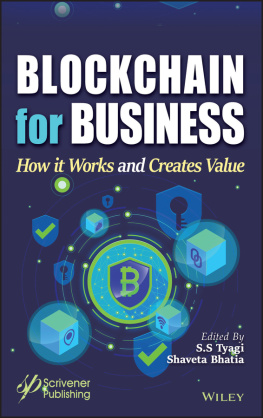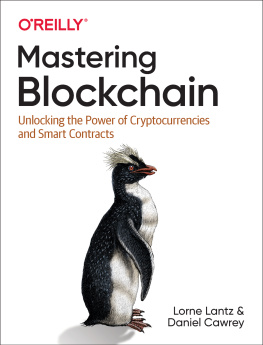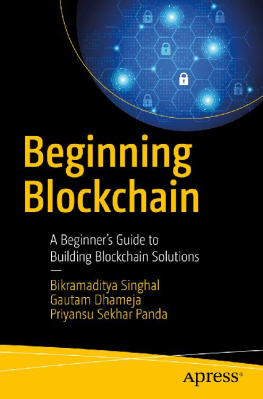
Scrivener Publishing
100 Cummings Center, Suite 541J
Beverly, MA 01915-6106
Publishers at Scrivener
Martin Scrivener ()
Phillip Carmical ()
Blockchain for Business
How It Works and Creates Value
Edited by
S.S. Tyagi
and
Shaveta Bhatia

This edition first published 2021 by John Wiley & Sons, Inc., 111 River Street, Hoboken, NJ 07030, USA and Scrivener Publishing LLC, 100 Cummings Center, Suite 541J, Beverly, MA 01915, USA
2021 Scrivener Publishing LLC
For more information about Scrivener publications please visit www.scrivenerpublishing.com.
All rights reserved. No part of this publication may be reproduced, stored in a retrieval system, or transmitted, in any form or by any means, electronic, mechanical, photocopying, recording, or otherwise, except as permitted by law. Advice on how to obtain permission to reuse material from this title is available at http://www.wiley.com/go/permissions.
Wiley Global Headquarters
111 River Street, Hoboken, NJ 07030, USA
For details of our global editorial oces, customer services, and more information about Wiley products visit us at www.wiley.com.
Limit of Liability/Disclaimer of Warranty
While the publisher and authors have used their best efforts in preparing this work, they make no representations or warranties with respect to the accuracy or completeness of the contents of this work and specifically disclaim all warranties, including without limitation any implied warranties of merchant- ability or fitness for a particular purpose. No warranty may be created or extended by sales representatives, written sales materials, or promotional statements for this work. The fact that an organization, website, or product is referred to in this work as a citation and/or potential source of further information does not mean that the publisher and authors endorse the information or services the organization, website, or product may provide or recommendations it may make. This work is sold with the understanding that the publisher is not engaged in rendering professional services. The advice and strategies contained herein may not be suitable for your situation. You should consult with a specialist where appropriate. Neither the publisher nor authors shall be liable for any loss of profit or any other commercial damages, including but not limited to special, incidental, consequential, or other damages. Further, readers should be aware that websites listed in this work may have changed or disappeared between when this work was written and when it is read.
Library of Congress Cataloging-in-Publication Data
ISBN 978-1-119-71104-9
Cover image: Pixabay.Com
Cover design by: Russell Richardson
Set in size of 11pt and Minion Pro by Manila Typesetting Company, Makati, Philippines
Printed in the USA
10 9 8 7 6 5 4 3 2 1
Preface
The motivation behind this book was the desire to impart succinct knowledge in the field of blockchain technologya technology that has been singled out as a pillar of the Fourth Industrial Revolution by World Bank. However, it was written not only to fulfill the desire of the editors and contributing authors but also to address the desire for such a book expressed by all the technical students, researchers, academicians, and professionals who we interact with on a daily basis. We understood the need for this book after observing numerous sessions and independent lectures on the subject of blockchain technology. It was evident that blockchain technology is currently one of the most important futuristic technologies, and that researchers and professionals all across the world are beginning to show tremendous interest in learning about this piece of technology.
The world essentially became aware of blockchain technology way back in 2008 with its first ever massive-scale implementation in the form of a digital currency called Bitcoin, introduced in Satoshi Nakamotos whitepaper. However, a lesser known fact is that the first occurrence of blockchain technology and its associated concepts was observed in papers published from 1991 to 1997 titled How to Time-Stamp a Digital Document, Improving the Eciency and Reliability of Digital Time-Stamping, and Secure Names for Bit-Strings authored by W. Scott Stornetta et al.also known as the founding fathers of blockchain technologythe mention of which can be found in the references of Satoshi Nakamotos bitcoin whitepaper.
When LinkedIn ranked blockchain technology as the number-one hard skill for 2020, we could sense the sudden influx of further interest in the technology, which cemented the idea of this book in our minds. This book has taken the shape of a reference as well as a textbook that can help academics, researchers, professionals, and experts alike. The approach followed in the book is that of a reference manual, starting with certain very important blockchain technology-related topics, including an introduction to the technology, a discussion of the ecosystem that people have started building around it and other topics (i.e., Ethereum, Wallets, Governance, Bitcoin), its challenges, and many more.
Furthermore, this book takes a deep dive into the inclusion of additional technologies, such as the Internet of Things, to discuss the changes rendered in the areas of supply chain management, identity management, etc. Blockchain applications are focused on in order to provide viable references to the readers and help them imagine real-world implementations across other sectors.
Another benefit of the book is the inclusion of business use cases that give a new dimension to the knowledge imparted. Practical concepts are discussed beyond the expected theory, which should help the readers obtain an added advantage as they go through the chapters discussed below.
In , Introduction to Blockchain, after blockchain is defined, its importance is discussed in the current scenario. Here the author explains the concepts of de-anonymization, identity privacy preservation, and the future of blockchain regulation with business model challenges.
In , The Scope of Blockchain Ecosystem, the delineation of the foundation of the blockchain ecosystem in businesses is dealt with, explaining how blockchain acts as a game changer and drilling down to a level of detail about the effect that energy production from business ecosystem has on the planet.
In , Business Use Cases of Blockchain Technology, a detailed discussion is presented of bitcoin as a cryptocurrency that uses blockchain as its transactions medium. The author also discusses the double-spending problem, bitcoin mining, bitcoin ICO, and ICO token.
In , Ethereum, the aim is to bring together the concepts of Ethereum and smart contractors along with the creation of virtual machine in easy steps. The chapter also explains Ethereum installation, its workings, the concept of Ethereum gas, ways to buy ETH, and the workings of Smart contracts and DApps along with their decentralized application areas.
In , E-Wallet, an overview of wallet technology is presented, and the steps for creating and navigating an HD wallet are explained.
In , Blockchain and Governance: Theory, Applications, and Challenges, the advantages reaped by using blockchain infrastructure are highlighted along with ventures wherein blockchains have been utilized to bring about improvements from the current centralized implementations, and finally the challenges that need to be addressed before moving to a decentralized model of governance.
Next page







![Tiana Laurence [Tiana Laurence] - Blockchain For Dummies](/uploads/posts/book/119706/thumbs/tiana-laurence-tiana-laurence-blockchain-for.jpg)


